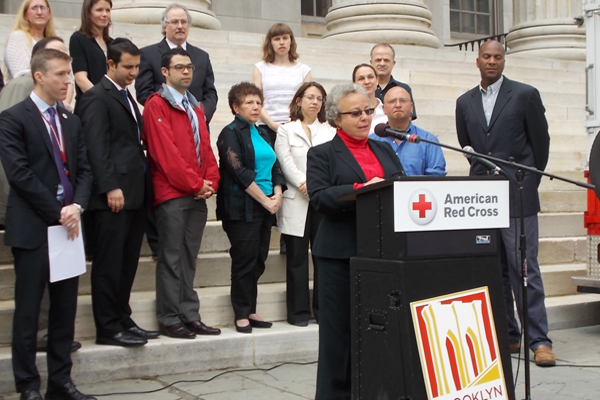
Photo by: Norman Oder
BCF President Marilyn Gelber announces the Red Cross grant outside Brooklyn’s Borough Ball.
As coastal Brooklyn communities slog through post-Sandy recovery, they’re getting a boost from the American Red Cross, a $1.25 million gift that comes not without controversy related to whether the giant disaster relief organization should have distributed more than two-thirds of the $300 million it has raised since the storm hit in late October 2012.
The grant award to the Brooklyn Community Foundation (which also helps fund Brooklyn Bureau) will be used for the foundation’s Brooklyn Recovery Fund, which has already given more than $2 million to help organizations in Canarsie, Coney Island, Gerritsen Beach, Red Hook and Sheepshead Bay. The fund was launched in collaboration with the Brooklyn Borough President’s Office and the Brooklyn Chamber of Commerce.
“We’re going to be here as long as we are needed,” declared Josh Lockwood, CEO of the American Red Cross Greater New York Region, at a press conference yesterday outside Borough Hall. He noted that the Red Cross was helping in New Orleans five years after Hurricane Katrina and in Joplin, Mo. two years after a deadly tornado.
The foundation, said BCF President Marilyn Gelber, wants “to send a message to all of our neighbors who are very much in need: you are not forgotten.” Brooklyn suffered the biggest hit among the five boroughs, she noted; nearly half of the 700,000 Brooklynites in neighborhoods along the borough’s coastline were in Sandy’s direct path.
Some of the money will go directly into rebuilding, while other funds will bolster the infrastructure for further recovery. As Gelber later elaborated: “Our investment has been to assess the needs, build the networks, put people in a position so they’re able to access the big money, which is ultimately coming from the public sector.”
Indeed, the money raised privately is dwarfed by the $60 billion federal relief package that will be allocated by states. Gelber suggested that Brooklyn might ultimately need more than $1 billion. “We put a band-aid on a situation that requires major surgery.”
Neighborhood voices
Representatives of organizations in the five highlighted neighborhoods praised past support and noted the need for more. Ken Soloway of the Kings Bay Y, representing the Sheepshead Bay Road to Recovery coalition, said the foundation had “set the bar” as a funder, helping the coalition create a multi-ethnic needs assessment to reach immigrants and to build “a real outreach network.”
Judi Orlando, executive director of the Astella Development Corporation in Coney Island, said that foundation money had allowed Astella to set up a trailer to host multiple nonprofits, and to to make 35 grants to community-based and faith-based organizations, as well as training residents on mold remediation and other tasks.
The new funds will help with reconstruction of houses, job-training for individuals, and efforts to revive Coney’s Mermaid Avenue commercial corridor, where 80 percent of businesses are back on a street that was once “a river.”
Nick Curattalo of Gerritsen Beach Sandy Relief was thankful but by no means relieved: “To be honest, we’ll still a long ways away.” At most 150 of 650 families surveyed are completely back, while others are slowly rebuilding and some ten to 15 percent have given up, he said.
Delay in distribution?
Fueled by a recent AP article in which some disaster relief experts criticized the Red Cross for not spending more than one-third of the $303 million it raised, given the harsh conditions faced by storm victims and the organization’s expertise in relief , reporters pressed Lockwood to further justify the organization’s record. (At the same time, eleven Council members, including Speaker Christine Quinn, expressed dismay that the money was unspent, though Mayor Bloomberg deferred to the Red Cross. Quinn had previously criticized the organization for a slow initial response.)
“We have been spending funds since before, during, and after the storm,” he replied, noting that not only was the Red Cross still writing checks of up to $10,000 per family and supporting efforts like that of the foundation, “we’re working on an unmet needs roundtable” to make sure no one’s missed.
“We are committed to expending all of these funds, and proud to be doing so,” he added. “We are going to see emerging needs over time that we want to be prepared to address. (The Red Cross has said it will not divert any funds to other purposes.)
Gelber defended the record, nothing that there’s been “enormous discussion” in philanthropic circles about the pace of spending. “Frankly, not all needs emerge instantly,” she said. “I think what the Red Cross is doing, by creating a follow-up fund, for Brooklyn, maybe for the other boroughs, that’s a pretty good way to go about [it]… You can’t approach a problem with the scale and scope of this with a cookie cutter.”
“I’m not saying ‘be patient,'” she added. “But that doesn’t mean spending the entire amount of donors’ money in six months or seven months… It’s probably going to take 18 to 24 months to work itself through.”
“You could always spend faster, but that doesn’t mean it’s effective and efficient,” observed Orlando. “I think the Red Cross is doing well.”
Ire at insurance companies
If the Red Cross was an understandable media target, a much more contentious exchange might have occurred had the press conference included what some consider the real villains of Sandy: the insurance companies.
“They keep on talking about the definition of wind and of flood,” declared Borough President Marty Markowitz pugnaciously. “As far as I’m concerned, those insurance companies should be ashamed of themselves. They were there to take their premiums, they should do everything they can to make their insured whole.”
Curattalo was less combative, but equally pointed. Restorative funding for homeowners in his neighborhood, he said, “starts with the insurance companies, but that’s the problem.”








